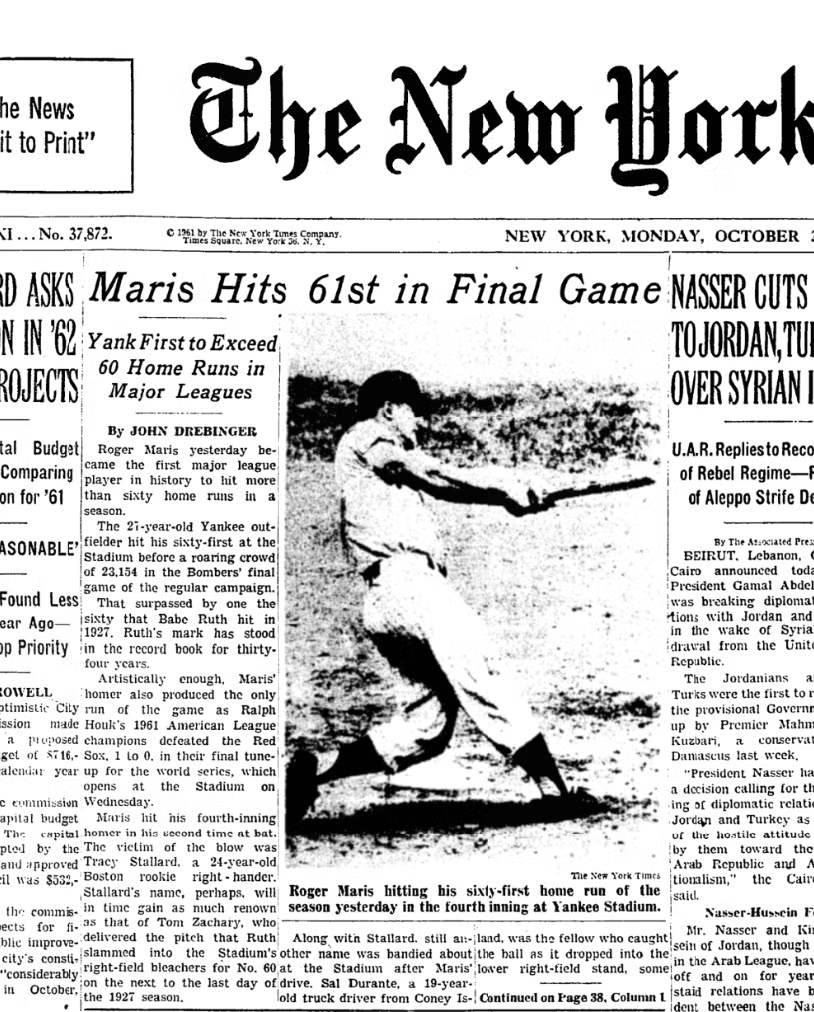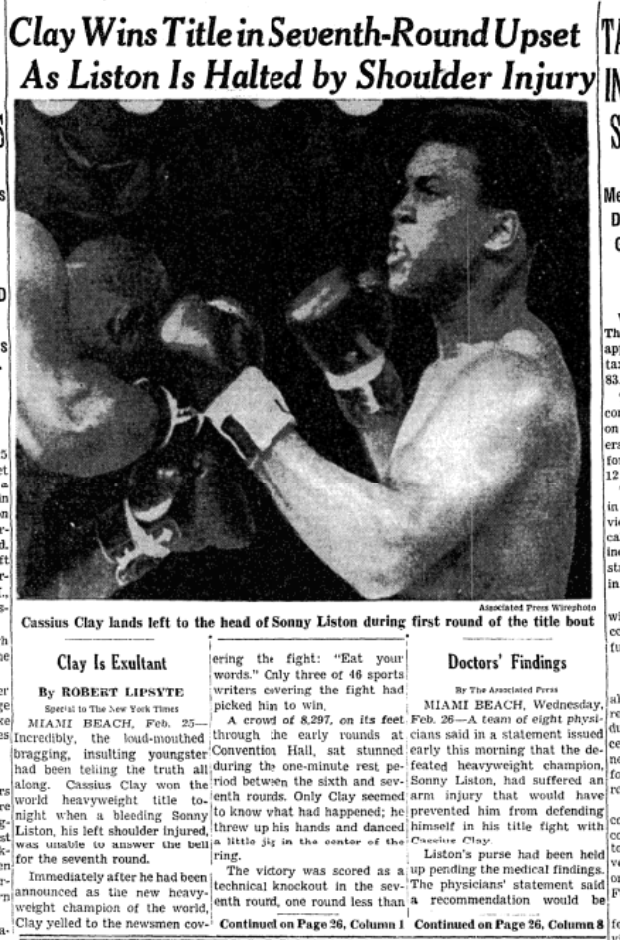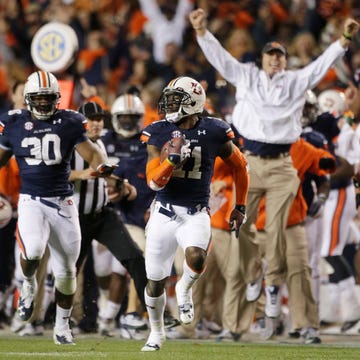The announcement this week that The New York Times will no longer have a sports department comes as the kind of shock you get when you turn a corner and a longtime store or restaurant or building is gone; even if you haven’t been there in years, it takes a moment to wrap your head around a world without it.
I grew up a sports fan in a New York Times household. In the ’70s and ’80s this meant waiting days for box scores to appear. Everything about the sports section reinforced the idea that sports really wasn’t that important in relation to the rest of the paper, or the world. I always got the sense that this was grown-ups writing about sports for grown-ups. A serious and un-fun paper with no comics or pulp, it seemed fitting to me that they had a columnist named Ira.
“The Times has never regarded its sports section with much respect,” says Robert Lipsyte, who joined the paper as a 19-year-old copy boy in 1957. “In the old days they said the Times’s sports department was Raquel Welch’s elbow. The only people you didn’t need to address as Mr. and Mrs. in the Times were felons and sports figures. We created our own mythology and our own importance and made our own changes.”
Following in the footsteps of Gay Talese, who as a Times sports reporter in the 1950s fought institutional rigidity to bring voice, point of view, and a novelist’s attention to detail, into his feature writing, Lipsyte held people accountable, challenged every traditional trope in the business, and gave no shits about attacking the sports hype machine. His Times colleague George Vecsey calls him “revolutionary.”
Lipsyte was the Muhammad Ali writer for the paper that refused to address the boxing legend as Ali for many years after he changed his name from Cassius Clay. Lipsyte had terrible fights with his editor about not using the name Ali to no avail. When he apologized in person, Ali patted Lipsyte on the head and said, “Don’t worry Bob you’re just the little brother of the white establishment.”
Lipsyte was the rarity at the Times—a genuine stylist. Of course, there was Red Smith, perhaps the most venerated sports columnist of the 20th Century, and one of the most stylish. Smith had over forty years of experience and was 66-years-old when he joined the Times, his glory days behind him. However, he earned the Pulitzer he won at the Times for a brilliant late run which included a political turn to the left.
Most of the Times sports staff had a left-leaning bent, which is why they seemed so familiar to me, raised in a liberal New York clan. Columnists such as Dave Anderson, Claire Smith, and Vecsey seemed like such decent, reasonable folks. I used to see Bill Rhoden ambling along Broadway on the Upper West Side, his long arms jangling by his side (his hands, gnarled by old sports injuries, looked as if they’d been sculpted by Rodin). Who are the people in your neighborhood?
The Times never stopped making sense. And it was this rational, calm approach that I later appreciated when fandom meant raised voices, slammed doors, and tears (being a Knicks and a Jets fan will do it to you). While I came to adore the juiciness of the tabloids with their bold headlines, gossip, fun, and viciousness, I developed a new appreciation for the Times. Being a red-ass, I found the evenness of a Times game report soothing.
“We, the Times sport deptartment, were a tight club,” says Vecsey. “I don’t miss the presence of sports in the paper because I’m not such a sports fan. But I miss the camaraderie in the building. The camaraderie spilled over in your life. We weren’t all friends. But if you were on the road and you got someone on the phone, editor, clerk, you felt all equal and part of something.”
While never considered a great sports department, the Times has done admirable work in investigative journalism, expansive Olympic coverage, and in-depth soccer reporting as well (though some in recent years felt the globalization of the department came at the expense of the traditional local teams). Visually, it’s been brilliant for many years—and the fact that the physical paper looked so different from the tabloids gave it an extra graphic appeal. The paper has long featured a deep bench, to name a few (and apologies to the many not mentioned here): beat writers from Leonard Koppett (one of the original champions of analytics) to Judy Battista. Murray Chass was terrific on baseball labor. Not sure I’ve ever read anyone write better game stories than Buster Olney when he covered the Yankees and Mets. Harvey Araton wrote superbly about basketball and tennis; Ira Berkow was a wonderful feature writer, as was Tony Kornheiser, who wasn’t around long; Richard Sandomir, unfailingly smart and wry writing about sports media; and Jere Longman, stellar interviewer, clever writer, was a master of featurizing event coverage so you wanted to read it, no matter how mundane the event.
For all the good work they did, however, there was always a feeling looking at the Times’s sports section that they tip-toed up to the edge of what they could be and then stepped back. There’s a looseness or breeziness or what-the-hellness that typifies great sports sections—the Philadelphia Daily News and Newsday in the ’60s, the Boston Globe in the ’70s, the L.A. Times in the ’80s. You’ve got to swing from the heels more often than the Times did to have a really great sports section. And yet, they were our sports section and they never sucked.
Endings are the hardest. It’s not easy going out with grace and the Times’s ham-fisted announcement this week didn’t buck the trend. “I feel sad and I feel suspicious,” says Lipsyte. “Outsourcing sports to The Athletic is pretty fucking clever because they are a non-union shop. This is a continuing attempt by the paper to gain back a lot of control that they are losing.”
The sports department has been reassigned at the paper. John Branch, an absolute beast of a feature writer, got off the best line earlier this week on Twitter when he said: “Now for the dispersal draft.” Tyler Kepner, one of the two or three best baseball writers in the country, who has grinded for years to reach elite status moves to the national desk as of the end of September. That means he’ll cover the U.S. Open but the World Series can go fuck itself—unless of course he is permitted to stray from the national desk for such trite matters comes October. Again, we are secure in knowing how the Times feels about sports.
Branch and Kepner—and many of the other fine Times talent—will survive, of course, as will the paper. But are any of us better off? And, even more depressing, is this a harbinger of things to come at newspapers around the country? The grown-ups are leaving the room.














